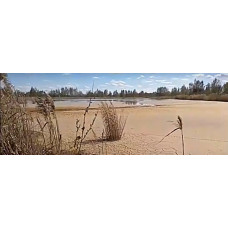Mud flat - shallow areas of rivers and lakes with deposition of fine-grained material with high content of organic matter.
Are coastal wetlands that form in tidal zones where sediments have been deposited by tides or rivers. A global analysis published in 2019 found that tidal flat ecosystems around the world are as extensive as mangroves, covering at least 127,921 km2 (49,391 square miles) of the Earth's surface. They are found in sheltered areas such as bays, channels, lagoons, and estuaries; they also occur in freshwater lakes and salt lakes (or inland seas) where many rivers and streams end. Mud flats can be thought of geologically as exposed layers of bay silt resulting from the deposition of estuarine silts, clays, and aquatic animal detritus. Most of the sediments within the mud flat are in the tidal zone, thus the flat is submerged and exposed approximately twice a day.
In the past, tidal flats were considered unhealthy, economically unimportant areas and were often excavated and turned into agricultural land.
Mud flat
Tags: mud flat

